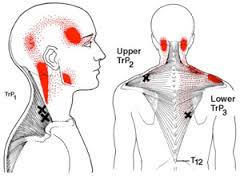Neck pain is really common.
Thankfully, most neck pain is not related to anything structurally wrong, but more a warning sign from your body telling you, "it's time to move".
Your muscles don't like stagnant conditions, as the blood flow is restricted and creates acidic conditions in the tissues which contributes to the pain experience.
If you can, pay close attention and become aware of the early stages of stiffness building up in your neck and shoulders.
If you can get moving as soon as possible, there's a good chance you can avoid the downward spiral that often involves more intense neck pain, restricted movement and headaches.
These set of four exercises targets the upper back (thoracic spine), which is often very stiff in people who experience frequent bouts of neck pain.
Cat-Cow
Start on your hands and knees with your back in a neutral position.
Arch your back, lifting your head up and pushing your tail bone out, making a dish with your spine.
Hold this position for one breath.
Next, arch your upper back by tucking your head and tail bone in and pulling your belly button in towards your spine, making a curve through your back. Exhale completely as you activate your deep core stabilisers.
Repeat x 10 times
Thread The Needle
Bring yourself up onto your hands and knees.
Your hands should be under your shoulders and your hips over your knees.
Take one hand off the floor and reach in and through between your other hand and leg on that side.
Allow your shoulder and head to follow, moving down towards the floor as your hand reaches through.
Allow your upper back to twist and rest your head gently on the mat.
You should feel a stretch in your upper back and shoulder blade.
Hold for 30 seconds and then repeat on the other side.
Push-Up To Side Plank
Push yourself up into a plank position with your hands under your shoulders and
Perform a half push up.
As you're coming up, rotate your body, turning one arm up towards the ceiling.
Allow your head and body to follow the movement.
Your may rotate a little on the balls of your feet.
Return your hand to the floor and repeat on the other side. Repeat x 3 each side.
Thoracic Mobilisation On The Foam Roller
Lie with a foam roller in your mid-back, and hug your arms across your chest to open up the upper back.
Lift your hips off the mat, and roll back and forth for about 30 seconds, pushing with your legs. You may feel a few cracks and pops which is a great sign your are releasing the joint stiffness.
Try spending 5 mins every morning and night and see how it helps your neck pain.
If you have any questions please contact us dan@kinfolkwellness.com.au
If you'd like to get a more personal assessment and treatment of your neck pain, please use our easy online booking system below to make an appointment:





























